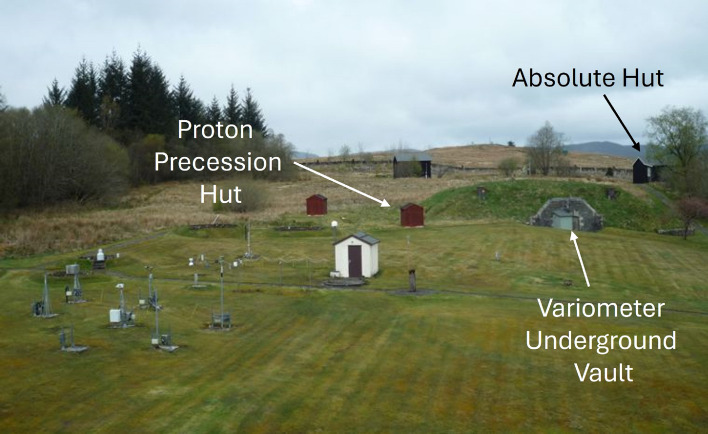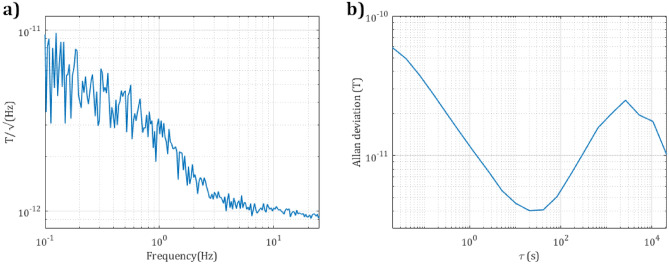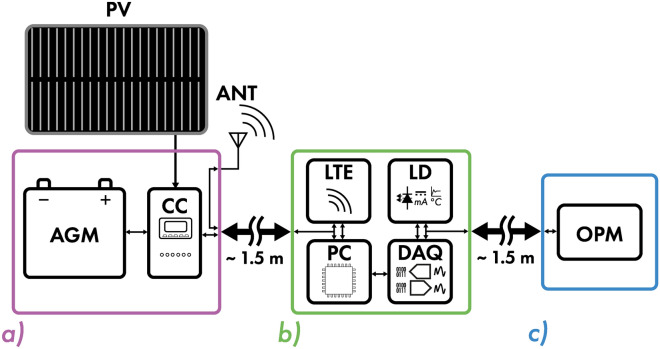Abstract
Spatial variation in the intensity of magnetospheric and ionospheric fluctuations during solar storms creates ground-induced currents, of importance in both infrastructure engineering and geophysical science. This activity is presently measured using a network of ground-based magnetometers, typically consisting of extensive installations at established observatory sites. We show that this network can be enhanced by the addition of remote quantum magnetometers which combine high sensitivity with intrinsic calibration. These nodes utilize scalable hardware and run independently of wired communication and power networks. We demonstrate that optically pumped magnetometers, utilizing mass-produced and miniaturized components, offer a single scalable sensor with the sensitivity and stability required for space weather observation. We describe the development and deployment of an off-grid magnetic sensing node, powered by a solar panel, present observed data from periods of low and high geomagnetic activity, and compare it to existing geomagnetic observatories.
Subject terms: Quantum metrology, Magnetospheric physics, Solar physics, Photonic devices, Sensors, Atom optics, Magneto-optics, Quantum optics
Introduction
Solar activity, resulting in the ejection of charged particles, induces a range of terrestrial effects, including geomagnetic storms1, ionospheric transients2,3 and ground-induced currents4. These effects of space weather can, in turn, disrupt vital infrastructure, such as satellite communication and location systems5,6, terrestrial power distribution7–9, telecommunication networks10, and transport networks11,12. In particular, ground-induced potentials of only a few V/km could significantly increase railway signaling error rates13.
The underlying geomagnetic variations are monitored in real-time by an international observatory network (INTERMAGNET)14. A typical geomagnetic observatory includes a range of magnetometers, combined to provide a stable, well-calibrated, sensitive record of the local geomagnetic field15. Three-axis vector fluxgate magnetometers are used in conjunction with inductive search coils, allowing higher bandwidth measurements, which enable observation and monitoring of global lightning storms, manifested as Schumann resonance typically represented as a fundamental peak at 7.86 Hz and its harmonics16. These sensors are complemented by scalar Overhauser proton magnetometers for increased stability17,18, establishing a calibrated baseline. This combination of sensors, installed in a well-controlled magnetic and thermal environment, enables geomagnetic measurement with high accuracy and precision. However, Overhauser proton magnetometers have limited bandwidth, while fluxgate magnetometers are not absolute, requiring weekly calibration19. Figure 1 shows the configuration of geomagnetic sensors at the British Geological Survey (BGS) Eskdalemuir Observatory site.
Fig. 1.
An annotated photograph showing the placement of different magnetometers at the Eskdalemuir BGS observatory including a proton precession magnetometer, a three-axis variometer, and a single-axis fluxgate theodolite. The proton magnetometer and fluxgate theodolite have been placed in above ground huts while a tri-axial fluxgate variometer is located in an underground vault that is temperature stabilized15. The site also hosts the UK Meteorological Office weather instruments in the left foreground.
From Fig. 1, it can be seen that a standard geomagnetic observatory consists of a number of huts which house different sensors while providing protective and temperature-stabilized environments to reduce unwanted instrumental effects, that can appear to be natural variations of the field. This approach increases the size, complexity, and cost of the observatory site, limiting the number of observatories that may be established globally.
Optically pumped magnetometers (OPMs), based on the detection of magneto-optical resonance in optically pumped atomic vapors, offer a combination of high sensitivity and stability20–24. OPMs may also be realized using mass-produced microfabricated components, packaged in compact and portable devices25,26. This combination of high sensitivity and long-term accuracy, achievable with the use of OPM sensors, allows a single compact sensor to operate as a variometer with absolute calibration. With further validation against the INTERMAGNET standard, OPMs of this type may offer a route to compact single-sensor observatories, augmenting observatory networks with additional compact sensing nodes. Here we demonstrate OPMs as distributed nodes, independent of mains power or observatory infrastructure, added to the network of established geomagnetic observatories. At present, there are relatively few magnetic observatories globally (less than 20027) so the addition of new nodes, increasing the spatial resolution of geomagnetic field measurements, will have practical benefits in understanding the relationships between geomagnetic transients and ground-induced current flows. This is particularly true at mid- to high-latitudes where sub-100 km structures appear in the auroral oval as it moves equatorwards during strong geomagnetic activity28. Finer scale resolution allows the most destructive features, such as highly curved magnetic transients, to be detected in real-time, which can provide rapid and localized warnings to infrastructure operators29.
Results
Space weather observation
The off-grid magnetometer was set up at Finlaggan on the Isle of Islay in Scotland (
Magnetic field measurements were sampled from the OPM at a sampling frequency of 50 samples per second (S/s). A file was created every three hours totalling 540 kS after which it was filtered and downsampled to 1 S/s, to match the cadence of the BGS measurements. Both the 50 S/s data and 1 S/s data were saved to the local storage of the PC. Downsampled data were then uploaded to a cloud server as a timestamped file following Coordinated Universal Time (UTC) from the internal PC clock, synchronized daily to time from the internet. The downsampling was performed to reduce network traffic, as only the 1 S/s data files were uploaded to the server.
The off-grid OPM setup on Islay was operational from 16:00 (UTC) on 04-Oct-2023. At the same time, a similarly configured OPM was in operation on the South Uist in the UK (
Fig. 2.
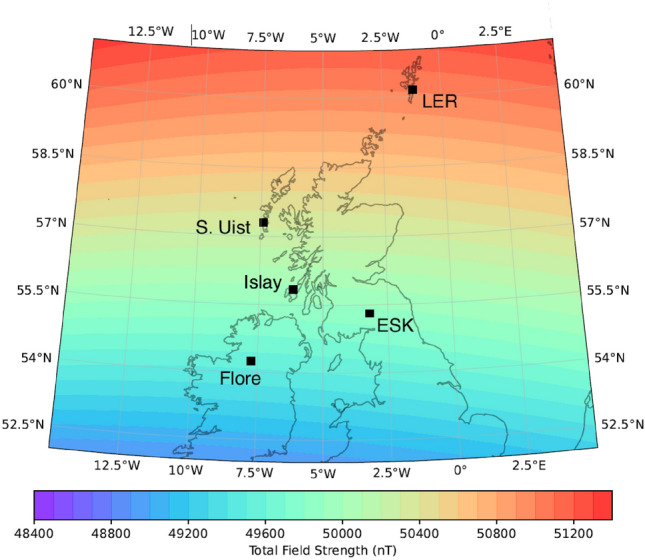
Map showing the location of the magnetometer network where observations were made. The colored contours show the expected background geomagnetic field magnitude for 01-Jan-2024, calculated using the CHAOS-7 geomagnetic field model31.
Fig. 3.
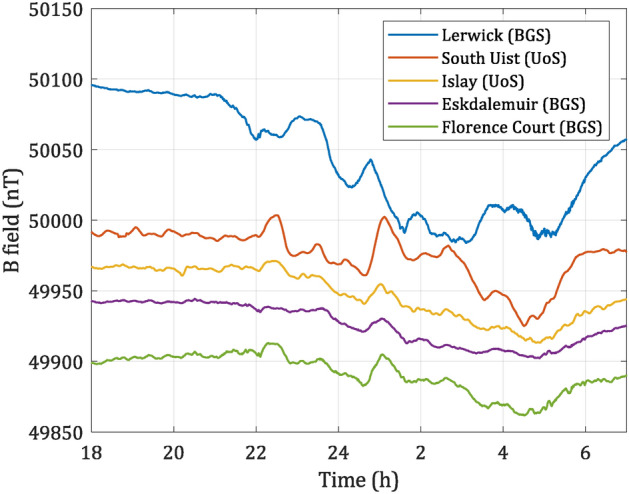
Magnetic data taken from 18:00 04-Oct-2023 to 7:00 05-Oct-2023 (UTC) at different sites. Lerwick, Eskdalemuir and Florence Court data were provided by the BGS. Data are ordered by latitude, offset vertically from one another with respect to Eskdalemuir data to improve readability. This data set shows “elevated activity” space weather conditions.
The main magnetic source of external field variation in the northern UK is the auroral electrojet, particularly during magnetic storms32. Due to the varying distance of the sensors from the auroral oval in this region, each records a different response—generally larger the closer its location to the auroral oval is. In addition, induced magnetic fields in the local subsurface contribute to smoothing or band-passing the magnetic field measured, as it is well known in Eskdalemuir33.
To present a comparison between an elevated magnetic activity as seen in Fig. 3 and typical magnetic activity, another set of data was taken the next day, over the same time frame. The resulting data are presented in Fig. 4. Here, it can be seen that magnetic deviation is much smaller (
Fig. 4.
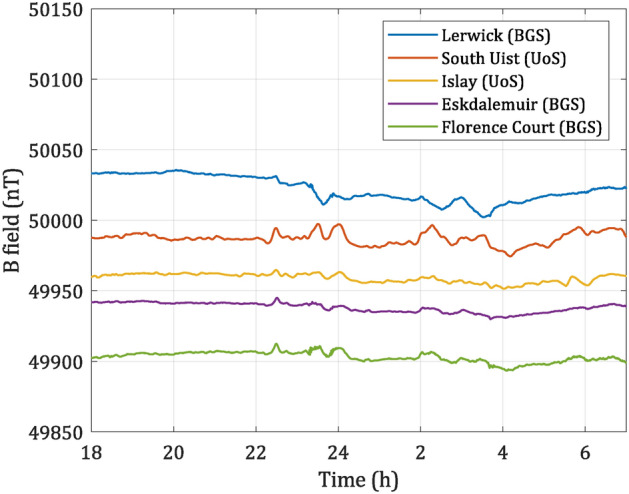
Magnetic data taken from 18:00 05-Oct-2023 to 7:00 06-Oct-2023 (UTC) at different sites. Lerwick, Eskdalemuir and Florence Court data were provided by the BGS. Data are ordered by latitude, offset vertically from one another with respect to Eskdalemuir data to improve readability. This data set shows “low activity” space weather conditions.
From Fig. 3, it can be seen that all the sensors differ in response, which is attributed to the physical location of test sites, though some common features exist. The diversity of magnitude obtained from different sites highlights the importance of high spatial resolution for space weather monitoring.
The variation of the magnetic field over 100 km scales means that local enhancements of the field can be accurately measured. This feeds into better models of the induced geoelectric field, which poses a threat to the grounded infrastructure34.
Discussion
The paper described the creation of a first-known field-deployed optically pumped magnetometer system for monitoring space weather. The Islay device was set up in a remote location, far from man-made magnetic noise sources (power lines, vehicles, etc.) while South Uist was closer to mains infrastructure. The deployed system was able to record space weather activity which was later compared to the data gathered from existing BGS observatories/variometers showing similar trends and also differences between observatories, associated with the subsurface geology and geographical location of the devices.
This OPM system, benefiting from new mass-produced components, now offers absolute magnetic measurements in a scalable and compact package. OPM systems of this type can be widely deployed in the future, enhancing the network of observatories, and providing better coverage of the geomagnetic events. The scalability of the approach was demonstrated by deploying another OPM system on South Uist which has recorded some events not seen by other observatories due to differences in their physical location, highlighting the importance of increasing spatial resolution through a wide network of observatories.
The system could benefit from additional improvements in the area of signal processing. By moving to a dedicated field-programmable gate array (FPGA) system, the level of integration would be increased, allowing for the replacement of the DAQ and PC in setup. This in turn would allow for lower power consumption of the system. The PC and DAQ currently used, limit the effective cadence of the sensor to
Methods
Optically pumped magnetometer with a micromachined (MEMS) cell
A simplified schematic of the physics package is shown in Fig. 5. The magnetometer used in this study is a radio-frequency,
Fig. 5.
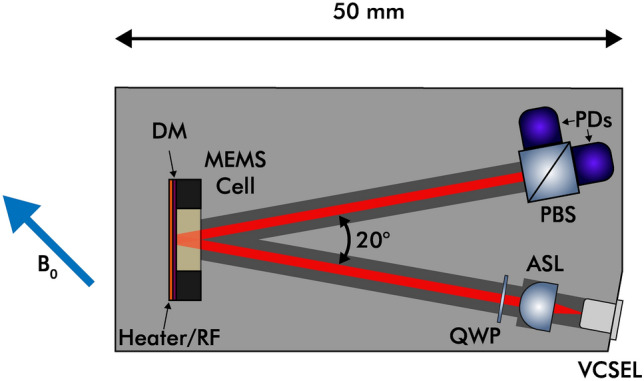
Simplified drawing of the OPM sensor head including vertical-cavity-surface-emitting-laser (VCSEL), aspheric lens (ASL), quarter-waveplate (QWP), micromachined cesium vapor cell (MEMS cell), dielectric mirror (DM), planar non-inductive ohmic heater/radio frequency field source (Heater/RF), polarizing beam splitter (PBS) and a pair of photodiodes (PDs). The angle between the VCSEL beam incidence and the resulting reflection (
The optics package is made out of 3D-printed material housed in an additional case to provide mounting points and protection from adverse weather conditions. The use of 3D-printing offers tight tolerances and high stability, allowing for a good reproducibility of optics packages with repeatable alignment and consistent sensor performance. 3D-printing is often used for manufacturing OPM sensor heads due to precision, mechanical robustness and inherent non-magnetic properties of the thermoplastics/resins used22,37,38. The interface to the sensor is provided with two,
The sensor performance is presented in Fig. 6 showing sensitivity and its stability with an overlapping Allan deviation39. The sensitivity of the sensor is within the limits of the one-second INTERMAGNET standard40 that the international network of magnetic observatories meets.
Fig. 6.
Noise spectral density of the OPM in a bandwidth of 0.1–25 Hz in (a) and Allan Deviation of the OPM running for 12 h in (b). The measurements were performed in a 5-layer mu-metal shield, with a 50
Field deployed optically pumped magnetometer setup
The simplified block diagram of the off-grid OPM setup is presented in Fig. 7. The system can be broken into three modules: power supply, control and processing, and sensor head.
Fig. 7.
Simplified block diagram of the off-grid OPM setup split into three main modules: (a) Power supply, (b) control and processing, and (c) sensor head. Each is housed in an IP67-rated enclosure and connected with fully plastic and non-magnetic IP67-rated conduits. The setup includes: Lead-acid battery (AGM), charge controller (CC), personal computer (PC), 4G modem (LTE), Data acquisition (DAQ), laser driver (LD), optically pumped magnetometer (OPM). The setup is powered by a photovoltaic panel (PV) covering the power supply module. The antennas (ANT) used for LTE communication are present on the enclosure housing the power supply.
The power supply module houses a lead acid battery and a charge controller. The battery has a total capacity of 160 Ah (1920 Wh) and is of absorbent glass mat (AGM) type. The AGM type was selected as it features good charge retention under changing environmental conditions that the setup will be exposed to in the field. The battery is charged using a monocrystalline PV panel, capable of supplying a maximum power of 400 W. The monocrystalline architecture offers better efficiency than polycrystalline panels42. During testing, the panel was capable of providing between
The control and processing module houses a mini portable computer (Compulab, fitlet2), a data acquisition board (Digilent, Analog Discovery 2), a custom laser driver, and an LTE modem (Multitech, Multiconnect Cell 100) for remote logging of data. The control system is housed in a die-cast aluminum enclosure, improving electromagnetic interference (EMI) rejection and improving cooling of all the components inside. The enclosure is rated to IP67 standard. The PC is powered directly from the charge controller as it accepts voltages in a range of 9–36 V which is within the operating range of AGM batteries. The PC has a typical power consumption of
The sensor head module houses the OPM described earlier. The enclosure is made out of polycarbonate, features an IP67 rating, and has been modified to be fully non-magnetic by replacing stainless steel bolts with nylon ones. As the enclosure is plastic, it provides better insulation to the OPM from changes in ambient temperature and improves its stability. Inside the enclosure, the sensor is mounted using a custom 3D printed mount which allows it to be tilted at angles between 0°–90°, enabling alignment of its sensitive axis with the Earth’s magnetic field vector, and minimizing the effects of heading errors43.
To provide communication and power between each module, cables were routed through non-magnetic, IP67-rated, 25 mm outer-diameter conduits. The power supply module and the processing module are separated by
The site is visited for maintenance every couple of months, which includes cleaning solar panels and checking that the fence, surrounding the system has not been tripped over by wildlife. The system for the most part can be monitored and debugged remotely.
Acknowledgements
The results presented in this paper rely on the data collected at Lerwick, Eskdalemuir and Florence Court. We thank the British Geological Survey for supporting its operation and INTERMAGNET for promoting high standards of magnetic observatory practice (www.intermagnet.org). This work was partially funded by EPSRC (Grant Numbers EP/X036391/1 and EP/T001046/1). J. P. M. gratefully acknowledges funding from a Royal Academy of Engineering Research Fellowship.
Author contributions
M. M. designed the system, installed the field trial and analyzed the data, with input from S. J. I, D. H. and E. R. S. J. I. designed the magnetometer sensor head and wrote the sensor software. A. S. B. designed and built the field station hardware and located the site. D. B. and J. P. M. developed and fabricated the Cs vapor cell. C. D. B. added interpretation of the data and comparison with reference measurements. All authors discussed the results and commented on the manuscript.
Data availability
The datasets used in the current study are available at (10.15129/4c091e48-f698-42c0-9863-e0b52fcd21c8). BGS magnetic data is publicly available at (https://imag-data.bgs.ac.uk/GIN/).
Declarations
Competing interests
The authors declare no competing interests.
Footnotes
Publisher’s note
Springer Nature remains neutral with regard to jurisdictional claims in published maps and institutional affiliations.
References
- 1.Extreme Space Weather: Impacts on Engineered Systems and Infrastructure (Tech. Rep, Royal Academy of Engineering, 2023).
- 2.Kutiev, I. et al. Solar activity impact on the Earth’s upper atmosphere. J. Space Weather Space Clim.3, A06. 10.1051/SWSC/2013028 (2013). [Google Scholar]
- 3.Bergeot, N. et al. The influence of space weather on ionospheric total electron content during the 23rd solar cycle. J. Space Weather Space Clim.3, A25. 10.1051/SWSC/2013047 (2013). [Google Scholar]
- 4.Pirjola, R., Viljanen, A., Pulkkinen, A., Kilpua, S. & Amm, O. Ground effects of space weather. In Effects of Space Weather on Technology Infrastructure (ed. Daglis, I. A.) 235–256 (Springer, 2005). [Google Scholar]
- 5.Hernández-Pajares, M. et al. The ionosphere: Effects, GPS modeling and the benefits for space geodetic techniques. J. Geodesy85, 887–907. 10.1007/S00190-011-0508-5 (2011). [Google Scholar]
- 6.Cerruti, A. P. et al. Effect of intense December 2006 solar radio bursts on GPS receivers. Space Weather6, S10D07. 10.1029/2007SW000375 (2008). [Google Scholar]
- 7.Oughton, E. J. et al. A risk assessment framework for the socioeconomic impacts of electricity transmission infrastructure failure due to space weather: An application to the United Kingdom. Risk Anal.39, 1022–1043. 10.1111/RISA.13229 (2019). [DOI] [PMC free article] [PubMed] [Google Scholar]
- 8.Kelly, G. S., Viljanen, A., Beggan, C. D. & Thomson, A. W. Understanding GIC in the UK and French high-voltage transmission systems during severe magnetic storms. Space Weather15, 99–114. 10.1002/2016SW001469 (2017). [Google Scholar]
- 9.Erinmez, I. A., Kappenman, J. G. & Radasky, W. A. Management of the geomagnetically induced current risks on the national grid company’s electric power transmission system. J. Atmos. Solar Terr. Phys.64, 743–756. 10.1016/S1364-6826(02)00036-6 (2002). [Google Scholar]
- 10.Medford, L. V., Lanzerotti, L. J., Kraus, J. S. & Maclennan, C. G. Transatlantic earth potential variations during the March 1989 magnetic storms. Geophys. Res. Lett.16, 1145–1148. 10.1029/GL016I010P01145 (1989). [Google Scholar]
- 11.Wik, M. et al. Space weather events in July 1982 and October 2003 and the effects of geomagnetically induced currents on Swedish technical systems. Ann. Geophys.27, 1775–1787. 10.5194/ANGEO-27-1775-2009 (2009). [Google Scholar]
- 12.Eroshenko, E. A. et al. Effects of strong geomagnetic storms on Northern railways in Russia. Adv. Space Res.46, 1102–1110. 10.1016/J.ASR.2010.05.017 (2010). [Google Scholar]
- 13.Patterson, C. J., Wild, J. A. & Boteler, D. H. Modeling, “wrong side’’ failures caused by geomagnetically induced currents in electrified railway signaling systems in the UK. Space Weather21, e3625. 10.1029/2023SW003625 (2023). [Google Scholar]
- 14.INTERMAGNET—International Real-Time Magnetic Observatory Network. https://intermagnet.org/ (2024).
- 15.British Geological Survey. G-DAS Geomagnetic Data Acquisition System (2002).
- 16.Füllekrug, M. Schumann resonances in magnetic field components. J. Atmos. Terr. Phys.57, 479–484. 10.1016/0021-9169(94)00075-Y (1995). [Google Scholar]
- 17.Overhauser, A. W. Polarization of nuclei in metals. Phys. Rev.92, 411. 10.1103/PhysRev.92.411 (1953). [Google Scholar]
- 18.Abragam, A. Overhauser effect in nonmetals. Phys. Rev.98, 1729. 10.1103/PhysRev.98.1729 (1955). [Google Scholar]
- 19.Love, J. J. Magnetic monitoring of earth and space. Phys. Today61, 31–37. 10.1063/1.2883907 (2008). [Google Scholar]
- 20.Ingleby, S., Griffin, P., Dyer, T., Mrozowski, M. & Riis, E. A digital alkali spin maser. Sci. Rep.12, 1–7. 10.1038/s41598-022-16910-z (2022). [DOI] [PMC free article] [PubMed] [Google Scholar]
- 21.Hunter, D. et al. Optical pumping enhancement of a free-induction-decay magnetometer. JOSA B40, 2664–2673. 10.1364/JOSAB.501086 (2023). [Google Scholar]
- 22.Rosner, M. et al. A highly drift-stable atomic magnetometer for fundamental physics experiments. Appl. Phys. Lett.120, 161102. 10.1063/5.0083854/2833371 (2022). [Google Scholar]
- 23.Wilson, N., Light, P., Luiten, A. & Perrella, C. Ultrastable optical magnetometry. Phys. Rev. Appl.11, 044034. 10.1103/PHYSREVAPPLIED.11.044034 (2019). [Google Scholar]
- 24.Griffith, W. C. et al. Femtotesla atomic magnetometry in a microfabricated vapor cell. Opt. Express18, 27167–27172. 10.1364/OE.18.027167 (2010). [DOI] [PubMed] [Google Scholar]
- 25.Liew, L. A. et al. Microfabricated alkali atom vapor cells. Appl. Phys. Lett.84, 2694. 10.1063/1.1691490 (2004). [Google Scholar]
- 26.Kitching, J. et al. Microfabricated atomic magnetometers and applications. In 2008 IEEE Int. Freq. Control. Symp. FCS 789–794. 10.1109/FREQ.2008.4623107 (2008)
- 27.Love, J. J. & Chulliat, A. An international network of magnetic observatories. EOS Trans. Am. Geophys. Union94, 373–374. 10.1002/2013EO420001 (2013). [Google Scholar]
- 28.Smith, A. W., Freeman, M. P., Rae, I. J. & Forsyth, C. The influence of sudden commencements on the rate of change of the surface horizontal magnetic field in the United Kingdom. Space Weather17, 1605–1617. 10.1029/2019SW002281 (2019). [Google Scholar]
- 29.Dimmock, A. P. et al. On the regional variability of dB/dt and its significance to GIC. Space Weather18, 1–20. 10.1029/2020SW002497 (2020). [Google Scholar]
- 30.Matzka, J., Stolle, C., Yamazaki, Y., Bronkalla, O. & Morschhauser, A. The geomagnetic Kp index and derived indices of geomagnetic activity. Space Weather19, 1–21. 10.1029/2020SW002641 (2021). [Google Scholar]
- 31.Finlay, C. C. et al. The CHAOS-7 geomagnetic field model and observed changes in the South Atlantic Anomaly. Earth Planets Space72, 1–31. 10.1186/S40623-020-01252-9 (2020). [DOI] [PMC free article] [PubMed] [Google Scholar]
- 32.Beggan, C. D. Sensitivity of geomagnetically induced currents to varying auroral electrojet and conductivity models. Earth Planets Space67, 1–12. 10.1186/S40623-014-0168-9 (2015). [Google Scholar]
- 33.Hutton, V. R., Sik, J. M. & Gough, D. I. Electrical conductivity and tectonics of Scotland. Nature266, 617–620. 10.1038/266617a0 (1977). [Google Scholar]
- 34.Hübert, J. et al. Validating a UK geomagnetically induced current model using differential magnetometer measurements. Space Weather22, 1–16. 10.1029/2023SW003769 (2024). [Google Scholar]
- 35.Dyer, S. et al. Micro-machined deep silicon atomic vapor cells. J. Appl. Phys.132, 134401. 10.1063/5.0114762 (2022). [Google Scholar]
- 36.Krzyzewski, S. P., Perry, A. R., Gerginov, V. & Knappe, S. Characterization of noise sources in a microfabricated single-beam zero-field optically-pumped magnetometer. J. Appl. Phys.126, 452. 10.1063/1.5098088/157452 (2019). [DOI] [PMC free article] [PubMed] [Google Scholar]
- 37.Carter, T. R. et al. Four-channel optically pumped atomic magnetometer for magnetoencephalography. Opt. Express24, 15403–15416. 10.1364/OE.24.015403 (2016). [DOI] [PMC free article] [PubMed] [Google Scholar]
- 38.Dawson, R. et al. Portable single-beam cesium zero-field magnetometer for magnetocardiography. J. Opt. Microsyst.3, 044501. 10.1117/1.JOM.3.4.044501 (2023). [Google Scholar]
- 39.Allan, D. Statistics of atomic frequency standards. Proc. IEEE54, 221–230. 10.1109/PROC.1966.4634 (1966). [Google Scholar]
- 40.INTERMAGNET—International Real-Time Magnetic Observatory Network: Definitive 1-Second Standard. https://intermagnet.org/docs/technical/im_tn_06_v1_0.pdf (2024).
- 41.Mrozowski, M. S., Chalmers, I. C., Ingleby, S. J., Griffin, P. F. & Riis, E. Ultra-low noise, bi-polar, programmable current sources. Rev. Sci. Instrum.94, 4760. 10.1063/5.0114760 (2023). [DOI] [PubMed] [Google Scholar]
- 42.Wenham, S. R., Green, M. A., Watt, M. E., Corkish, R. P. & Sproul, A. B. Applied Photovoltaics 3rd edn. (Taylor and Francis, 2013). [Google Scholar]
- 43.Lee, W. et al. Heading errors in all-optical alkali-metal-vapor magnetometers in geomagnetic fields. Phys. Rev. A103, 063103. 10.1103/PHYSREVA.103.063103 (2021). [Google Scholar]
Associated Data
This section collects any data citations, data availability statements, or supplementary materials included in this article.
Data Availability Statement
The datasets used in the current study are available at (10.15129/4c091e48-f698-42c0-9863-e0b52fcd21c8). BGS magnetic data is publicly available at (https://imag-data.bgs.ac.uk/GIN/).



